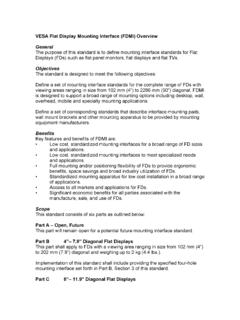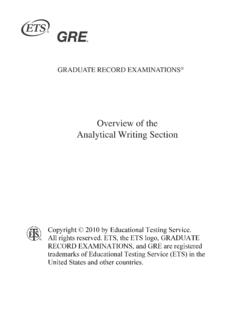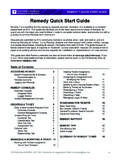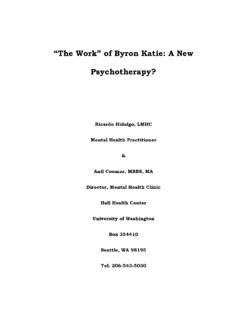Transcription of Medicare General Information, Eligibility, and Entitlement
1 Medicare General information , eligibility , and Entitlement Chapter 1 - General overview Table of Conte nts (Rev. 94, 10-16-15) Transmittals for Chapter 1 10 - General Program Benefits - Hospital Insurance (P art A) for Inpatient Hospital, Hospice, Home Health, and Skille d N ur s ing Fa c ility ( SN F) Se r vic e s - A Brief Description - Home Health Services - Supplementary Medical Insurance (Part B) - A Brief Description - Basis for P ayment 20 - Administration of the Medicare P rogram - Introduction - Financing the P rogram - D is c r imina tio n P r ohibite d - Fraud and Abuse - General - Definition and Examples of Fraud - Definition and Examples of Abuse 30 - Federal Government Administration of the Health Insurance P rogram - CMS Responsibilit ies - Public Health Service Responsibilities - State Agencies - Certification by State Agencies - Consultation by State Agencies.
2 Coordination by State Agencies 40 - Role of A/B MACs (A) and (HHH) - Assignment of A/B MAC (A) and (HHH) - A/B MAC (A) and (HHH) Service to Home Health Agencies (HHAs) 50 - Role of A/B MACs (B) 60 - Background and Responsibilit ies of the P eer Review Organization (P ROs) - P urpose of P RO Review for the Individua l Medicare Beneficiaries - P RO Responsibility for the Overall Approach to Health Care - Other P RO Responsibilit ies - Statutory Obligations of P ractitioners and Other P ersons - Responsibilit ies of Designated Agents Working With P ROs; Organizations Subcontracted for Review 70 - Institutiona l P lanning and Budgeting 80 - CMS Managed Modules for Software P rograms and P ricing/Coding Files 10 - General Program Benefits (Rev.)
3 1, 09-11-02) The Health Insurance for the Aged and Disabled Act (title XVIII of the Social Security Act), known as " Medicare ," has made available to nearly every American 65 years of age and older a broad program of health insurance designed to assist the nation's elderly to meet hospital, medical, and other health costs. Health insurance coverage has also been extended to persons under age 65 qualifying as disabled and those having end stage renal disease (ESRD) or Lou Gehrig's disease. The program includes two related health insurance programs--hospital insurance (HI) (Part A) and supplementary medical insurance (SMI) (Part B).
4 - Hospital Insurance (Part A) for Inpatient Hospital, Hospice, Home Health and Skilled Nursing Facility (SNF) Services - A Brief Description (Rev. 94, Issued: 10-16-15, Effective: 11-16-15, Implementation: 11-16-15) Hospital insurance is designed to help patients defray the expenses incurred by hospitalizat ion and related care. In addition to inpatient hospital benefits, hospital insurance covers posthospital extended care in SNFs and posthospital care furnished by a home health agency in the patient's home. Blood clotting factors, for hemophilia patients competent to use such factors to control bleeding without medical or other supervision, and items related to the administration of such factors, are also a Part A benefit for beneficiaries in a covered Part A stay.
5 The purpose of these additional benefits is to provide continued treatment after hospitalizat ion and to encourage the appropriate use of more economical alternatives to inpatient hospital care. P rogram payments for services rendered to beneficiaries by providers ( , hospitals, SNFs, and home health agencies) are generally made to the provider. In each benefit period, payment may be made for up to 90 inpatient hospital days, and 100 days of posthospital extended care services. Hospices also provide P art A hospital insurance services such as short-term inpatient care.
6 In order to be eligible to elect hospice care under Medicare , an individua l must be entitled to P art A of Medicare and be certified as being terminally ill. An individua l is considered to be terminally ill if the individua l has a medical prognosis that his or her life expectancy is 6 months or less if the illness runs its normal course. The Part A benefit categories of inpatient hospital services and SNF services are each subject to separate and mutually exclusive day limits, so that the use of benefit days under one of these benefits does not affect the number of benefit days that remain available under the other.
7 Accordingly, the 90 days of inpatient hospital benefits (plus 60 nonrenewable lifetime reserve days -- see P ub. 100-02, Medicare Benefit Policy Manual, chapter 5) that are available to a beneficiary in a hospital do not count against the 100 days of posthospital extended care benefits that are available in a SNF, and vice-versa. - Home Health Services (Rev. 28; Issued: 08-12-05; Effe ctive/Imple mentation: 09-12-05) To qualify for home health benefits under either P art A or P art B of the program, a beneficiary must be confined to his/her home, under the care of a physician, and in need of skilled nursing services on an intermittent basis, physical therapy, or speech-language pathology services.
8 Being "confined to the home" does not mean a beneficiary can never leave the home. See chapter 7 of the Benefit P olicy publication for the definition of homebound. A beneficiary who requires one or more of these services in the treatment of his/her illness or injury and otherwise qualifies for home health benefits is eligible to have payment made on his/her behalf for the skilled nursing, physical therapy or speech-language pathology services he needs, as well as for any of the other home health services specified in the law.
9 These services include occupational therapy, medical social services, the use of medical supplies and medical appliances, and the part-time or intermittent services of home health aides. Conversely, a patient who does not require intermittent skilled nursing or physical therapy or speech-language pathology services cannot qualify to have payment made under the program for any home health services furnished him. Excluded as home health services are the costs of housekeepers, food service arrangements, and transportation to outpatient facilities.
10 To be covered, the home health services must be needed for a condition for which the patient required inpatient hospital services or extended care services. See the chapter 7 of the Benefit P olicy publication for a description of services covered. Discharge from the hospital must have occurred in a month in which the patient has attained age 65 or was entitled to health insurance benefits under the disability or chronic renal disease provisions of the law. Home health services are services provided by a home health agency or by others under arrangements with such an agency.

















